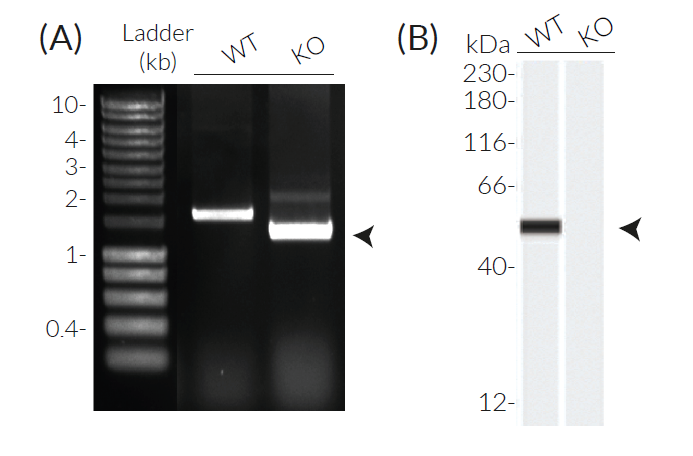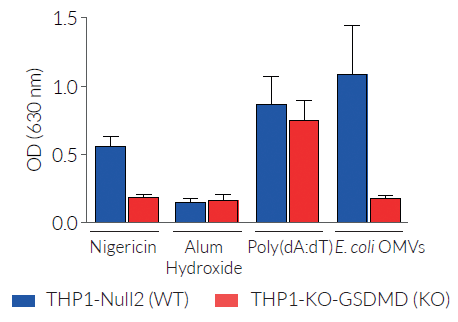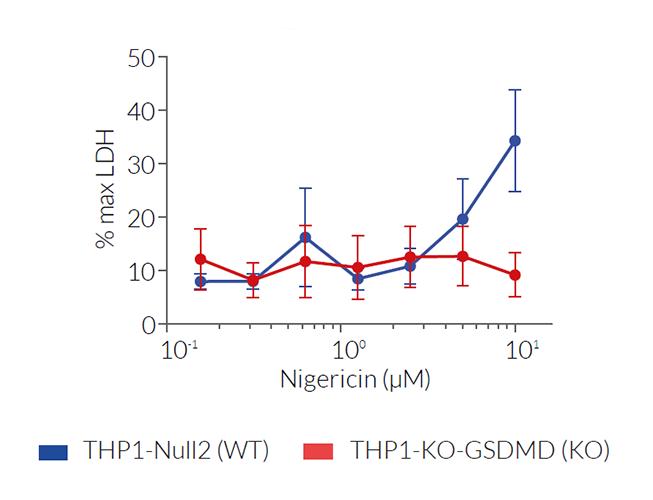Gasdermin-D KO THP-1 Cells
| Product | Unit size | Cat. code | Docs. | Qty. | Price | |
|---|---|---|---|---|---|---|
|
THP1-KO-GSDMD Cells GSDMD Knockout in THP-1 cells (human monocytes) |
Show product |
3-7 x 10e6 cells |
thp-kogsdmdz
|
|
||
|
THP1-KO-GSDMD vial Additional cell vial |
Show product |
3-7 x 10e6 cells |
thp-kogsdmdz-av
|
Notification: Reference #thp-kogsdmdz-av can only be ordered together with reference #thp-kogsdmdz.
Gasdermin D knockout in THP-1 cells

Inflammasome signaling in THP1-KO-GSDMD cells
Gasdermin D (GSDMD) is a cytoplasmic protein with a pore-forming ability that has been described as a major actor in early canonical and non-canonical inflammasome responses [1]. GSDMD pores are formed via its N-terminal domain following cleavage of the full-length GSDMD protein by caspase-1 or human CASP4/5 (CASP11 in mice). These pores allow the release of alarmins (e.g. HMGB1) and the secretion of mature IL-1β and IL-18 inflammatory cytokines.
InvivoGen has developed THP1-KO-GSDMD cells, which were generated from the human monocytic THP-1 cell line THP1-Null2, through the stable knockout of the GSDMD gene.
• THP1-KO-GSDMD cells – Knockout (KO) of the GSDMD gene
These cells exhibit impaired early IL-1β secretion and pyroptosis responses upon canonical and non-canonical inflammasome activation. Although these cells are fully KO for the GSDMD protein, mature IL-1β secretion is detected upon prolonged incubation with some inflammasome inducers. This observation illustrates the reported IL-1β secretion upon GSDMD-independent cell death [2, 3].
Features of THP1-KO-GSDMD cells:
- Generated from the parental cell line THP1-Null2
- Verified biallelic knockout of the GSDMD gene (DNA sequencing, PCR, and Western blot)
- Altered IL-1β secretion and pyroptosis early upon canonical and non-canonical inflammasome activation
For detecting and quantifying the release of mature human (h)IL-1β, InvivoGen provides HEK-Blue™ IL-1β sensor cells, which express an NF-κB-inducible SEAP reporter gene. QUANTI-Blue™ Solution allows rapid colorimetric detection and measure of SEAP activity by reading the optical density at 630-650 nm.
![]() Download our Practical guide on Inflammasomes
Download our Practical guide on Inflammasomes
References:
1. Kovacs S.B. & Miao E.A. 2017. Gasdermins: effectors of pyroptosis. Trends Cell. Biol. 27:673.
2. Schneider K.S. et al.,2018. The Inflammasome Drives GSDMD-Independent Secondary Pyroptosis and IL-1 Release in the Absence of Caspase-1 Protease Activity. Cell Rep. 21:3846.
3. Zeng C-H. et al., 2019. ATP induces caspase-3/gasdermin E-mediated pyroptosis in NLRP3 pathway-blocked murine macrophages. Apoptosis. 24(9-10):703-717.
Specifications
Antibiotic resistance: Zeocin®
Growth medium: RPMI 1640, 2 mM L-glutamine, 25 mM HEPES, 10% (v/v) heat-inactivated fetal bovine serum (FBS), 100 U/ml penicillin, 100 µg/ml streptomycin, 100 µg/ml Normocin™
Quality Control:
- Biallelic GSDMD knockout has been verified by DNA sequencing, PCR, Western blot (Wes™), and functional assays.
- The stability for 20 passages, following thawing, has been verified.
- These cells are guaranteed mycoplasma-free.
Contents
- 3-7 x 106 THP1-KO-GSDMD cells in a cryovial or shipping flask
- 1 ml of Zeocin® (100 mg/ml). Store at 4 °C or at -20 °C.
- 1 ml of Normocin™ (50 mg/ml). Normocin™ is a formulation of three antibiotics active against mycoplasmas, bacteria, and fungi.
![]() Shipped on dry ice (Europe, USA, Canada and some areas in Asia)
Shipped on dry ice (Europe, USA, Canada and some areas in Asia)
Details
GSDMD belongs to a family of six and ten gasdermins in humans and mice, respectively, which all have different expression patterns [1, 2]. GSDMD consists of two distinct domains, whereby the C-terminal domain exerts an auto-inhibitory function on the N-terminal domain.
GSDMD is cleaved by activated caspase-1 (CASP1) downstream of NLRP1, NLRP3, AIM2, NLRC4, or Pyrin canonical inflammasomes, or by activated CASP4/5 (human), CASP11 (mouse) non-canonical inflammasomes. The released GSDMD N-terminal domain oligomerizes to form 10-15 nm diameter pores at the cell membrane, thereby allowing the release of alarmins (e.g. HMGB1) and the secretion of mature IL-1β and IL-18 inflammatory cytokines. The accumulation of GSDMD pores in the membrane causes cell swelling and rupture, leading to an inflammatory cell death termed pyroptosis [1, 3].
Importantly, GSDMD links the canonical and non-canonical inflammasome responses with the pore formation leading to stress signals, such as cytosolic ion concentration imbalances (i.e. K+ efflux) and ATP release. These signals induce the activation of NLRP3 and CASP1-mediated IL-1β/IL-18 maturation and secretion [2, 4].
1. Kovacs S.B. & Miao E.A. 2017. Gasdermins: effectors of pyroptosis. Trends Cell. Biol. 27:673.
2. Groslambert M. & Py B. 2018. Spotlight on the NLRP3 inflammasome pathway. J. Inflamm. Res. 11:359.
3. Feng S. et al., 2018. Mechanisms of Gasdermin family members in inflammasome signaling and cell death. J. Mol. Biol. 430:3068.
4. Mathur A. et al., 2017. Molecular mechanisms of inflammasome signaling. J. Leuk. Biol. 103:233.










